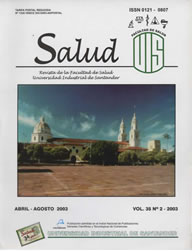Resumen
RESUMEN
OBJETIVO(S): A través de un estándar de oro, establecimos la calidad de la dieta y el patrón de consumo alimentario.
MATERIALES Y MÉTODOS: Estudio dietético prospectivo. Durante 1998, 97 adultos entre 20 y 40 años completaron un registro con pesaje del consumo de alimentos durante siete días consecutivos. El análisis fue conducido para describir la dieta en términos de la frecuencia del consumo por los grupos de alimentos sugeridos en las guías de alimentación para la población Colombiana.
RESULTADOS: La frecuencia de consumo/día por grupo de alimentos, es mayor en hombres. Por debajo de la frecuencia recomendada se encuentra la de frutas y grasas. En el límite inferior se encuentra la de lácteos. El 45.4% (IC: 44.1, 46.5) del total de la energía/día, proviene de los cereales, raíces, tubérculos y plátano, el 5.9% (IC: 5.2, 6.7) de las hortalizas, verduras y leguminosas verdes, el 11.1% (IC: 10.4, 11.9) de las frutas, el 25.8% (IC: 24.6, 26.9) de las carnes, huevos y leguminosas secas, el 10.5% (IC: 9.9, 11.1) de los lácteos, el 10.6% (IC: 8.5, 12.7) de las grasas y el 12.1% (IC: 11.5, 12.8) de los azúcares y dulces. Un 18.3% (IC: 13.8, 22.9) del total de la energía/día, proviene de bebidas alcohólicas.
CONCLUSIONES: Se necesitan estrategias que mejoren el patrón alimentario, enfatizando en el aumento del consumo de lácteos, cereales integrales, verduras, hortalizas, frutas, leguminosas y la reducción de bebidas alcohólicas. El patrón alimentario establecido comparado con la dieta promedio de América Latina, encaja dentro del modelo "d".
Palabras Clave: Estudio de la Dieta, Consumo de Alcohol, Nutrición, Hábitos Alimentarios, Registro Dietario, Método Epidemiológico.
ABSTRACT
OBJECTIVE: Through a standard of gold, we established the quality of the diet and the pattern of alimentary consumption.
MATERIALS AND METHODS: Study dietary prospective. During 1998, 97 adults between 20 and 40 years completed a registration with net weight of the consumption of foods during seven serial days. The analysis was carry to describe the diet in terms of the frequency of the consumption for the groups of foods suggested in the feeding guides for the Colombian population.
RESULTS: The frequency of intake/day for group of foods is bigger in men. Below the recommended frequency he/she is that of fruits and fatty. In the inferior limit he/she is the one of milky. 45.4% (IC: 44.1, 46.5) of the total of the energy/day, it comes from the cereals, roots, tubers and banana, 5.9% (IC: 5.2, 6.7) of the vegetables, vegetables and leguminous green, 11.1% (IC: 10.4, 11.9) of the fruits, 25.8% (IC: 24.6, 26.9) of the meats, eggs and leguminous dry, 10.5% (IC: 9.9, 11.1) of the milky ones, 10.6% (IC: 8.5, 12.7) of the fats and 12.1% (IC: 11.5, 12.8) of the sugars and sweet. 18.3% (IC: 13.8, 22.9) of the total of the energy/day, it comes from alcoholic drinks.
CONCLUSIONS: Are needed to Strategies improve the alimentary pattern, emphasizing in the increase of the consumption of milky, integral cereals, vegetables, fruits, leguminous and the reduction of alcoholic drinks. The stablished alimentary pattern compared with the diet average of Latin America, fits inside the pattern "d".
Key Words: Dietary Evaluation, Intake of Alcohol, Nutrition, Alimentary Habits, Dietary Record, Epidemiologic Method.
Se autoriza la reproducción total o parcial de la obra para fines educativos, siempre y cuando se cite la fuente.
Esta obra está bajo una Licencia Creative Commons Atribución 4.0 Pública Internacional.
